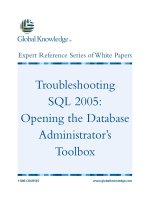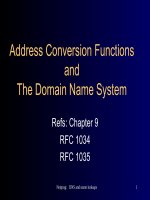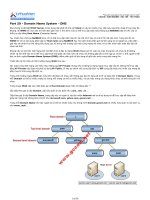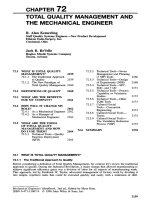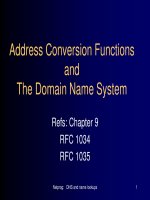Tài liệu Address Conversion Functions and The Domain Name System Refs doc
Bạn đang xem bản rút gọn của tài liệu. Xem và tải ngay bản đầy đủ của tài liệu tại đây (81.76 KB, 37 trang )
Netprog: DNS and name lookups 1
Address Conversion Functions
and
The Domain Name System
Refs: Chapter 9
RFC 1034
RFC 1035
Netprog: DNS and name lookups 2
Hostnames
• IP Addresses are great for computers
– IP address includes information used for
routing.
• IP addresses are tough for humans to
remember.
• IP addresses are impossible to guess.
– ever guessed at the name of a WWW site?
Netprog: DNS and name lookups 3
The Domain Name System
•The domain name system is usually
used to translate a host name into an IP
address .
• Domain names comprise a hierarchy so
that names are unique, yet easy to
remember.
Netprog: DNS and name lookups 4
DNS Hierarchy
edu com org jp
rpi albany
Netprog: DNS and name lookups 5
Host name structure
• Each host name is made up of a
sequence of labels separated by
periods.
– Each label can be up to 63 characters
– The total name can be at most 255
characters.
• Examples:
– whitehouse.gov
– barney.the.purple.dinosaur.com
– monica.cs.rpi.edu
Netprog: DNS and name lookups 6
Domain Name
• The domain name for a host is the
sequence of labels that lead from the
host (leaf node in the naming tree) to
the top of the worldwide naming tree.
• A domain is a subtree of the worldwide
naming tree.
Netprog: DNS and name lookups 7
Top level domains
• edu, gov, com, net, org, mil, …
• Countries each have a top level domain
(2 letter domain name).
• New top level domains include:
.aero .biz .coop .info .name .pro
Netprog: DNS and name lookups 8
DNS Organization
• Distributed Database
– The organization that owns a domain name
is responsible for running a DNS server
that can provide the mapping between
hostnames within the domain to IP
addresses.
– So - some machine run by RPI is
responsible for everything within the
rpi.edu domain.
Netprog: DNS and name lookups 9
rpi.edu
DNS DB
rpi.edu
DNS DB
• There is one primary server for a
domain, and typically a number of
secondary servers containing replicated
databases.
DNS Distributed Database
rpi.edu
DNS DB
Authoritative
rpi.edu
DNS DB
Replicas
rpi.eduDNS server
Netprog: DNS and name lookups 10
DNS Clients
• A DNS client is called a resolver.
• A call to
gethostbyname()is handled by
a resolver (typically part of the client).
• Most Unix workstations have the file
/etc/resolv.conf that contains the
local domain and the addresses of DNS
servers for that domain.
Netprog: DNS and name lookups 11
/etc/resolv.conf
domain rpi.edu
128.113.1.5
128.113.1.3
Netprog: DNS and name lookups 12
nslookup
• nslookup is an interactive resolver that
allows the user to communicate directly
with a DNS server.
• nslookup is usually available on Unix
workstations. (dig and host are also
DNS clients).
Netprog: DNS and name lookups 13
DNS Servers
• Servers handle requests for their
domain directly.
• Servers handle requests for other
domains by contacting remote DNS
server(s).
• Servers cache external mappings.
Netprog: DNS and name lookups 14
Server - Server Communication
• If a server is asked to provide the
mapping for a host outside it’s domain
(and the mapping is not in the server
cache):
– The server finds a nameserver for the
target domain.
– The server asks the nameserver to provide
the host name to IP translation.
• To find the right nameserver, use DNS!
Netprog: DNS and name lookups 15
DNS Data
• DNS databases contain more than just
hostname-to-address records:
– Name server records NS
– Hostname aliases CNAME
– Mail Exchangers MX
– Host Information HINFO
Netprog: DNS and name lookups 16
The Root DNS Server
• The root server needs to know the
address of 1st (and many 2nd) level
domain nameservers.
edu com org jp
albany
rpi
Netprog: DNS and name lookups 17
Server Operation
• If a server has no clue about where to
find the address for a hostname, ask the
root server.
• The root server will tell you what
nameserver to contact.
• A request may get forwarded a few
times.
Netprog: DNS and name lookups 18
DNS Message Format
HEADER
QUERIES
Response RESOURCE RECORDS
Response AUTHORITY RECORDS
Response ADDITIONAL INFORMATION
HEADER
QUERIES
Response RESOURCE RECORDS
Response AUTHORITY RECORDS
Response ADDITIONAL INFORMATION
Netprog: DNS and name lookups 19
DNS Message Header
• query identifier
• flags
• # of questions
•# of RRs
• # of authority RRs
• # of additional RRs
1
6
b
i
t fie
ld
s
Re
s
p
o
n
s
e
Netprog: DNS and name lookups 20
Message Flags
• QR: Query=0, Response=1
• AA: Authoritative Answer
• TC: response truncated (> 512 bytes)
• RD: recursion desired
• RA: recursion available
• rcode: return code
Netprog: DNS and name lookups 21
Recursion
• A request can indicate that recursion is
desired - this tells the server to find out
the answer (possibly by contacting other
servers).
• If recursion is not requested - the
response may be a list of other name
servers to contact.
Netprog: DNS and name lookups 22
Question Format
• Name: domain name (or IP address)
• Query type (A, NS, MX, …)
• Query class (1 for IP)
Netprog: DNS and name lookups 23
Response Resource Record
• Domain Name
• Response type
• Class (IP)
• Time to live (in seconds)
• Length of resource data
• Resource data
Netprog: DNS and name lookups 24
UDP & TCP
• Both UDP and TCP are used:
– TCP for transfers of entire database to
secondary servers (replication).
– UDP for lookups
– If more than 512 bytes in response -
requestor resubmits request using TCP.
Netprog: DNS and name lookups 25
Lots more
• This is not a complete description !
• If interested - look at:
– RFC 1034: DNS concepts and facilities.
– RFC 1035: DNS implementation and
protocol specification.
– play with nslookup.
– Look at code for BIND (DNS server code).


